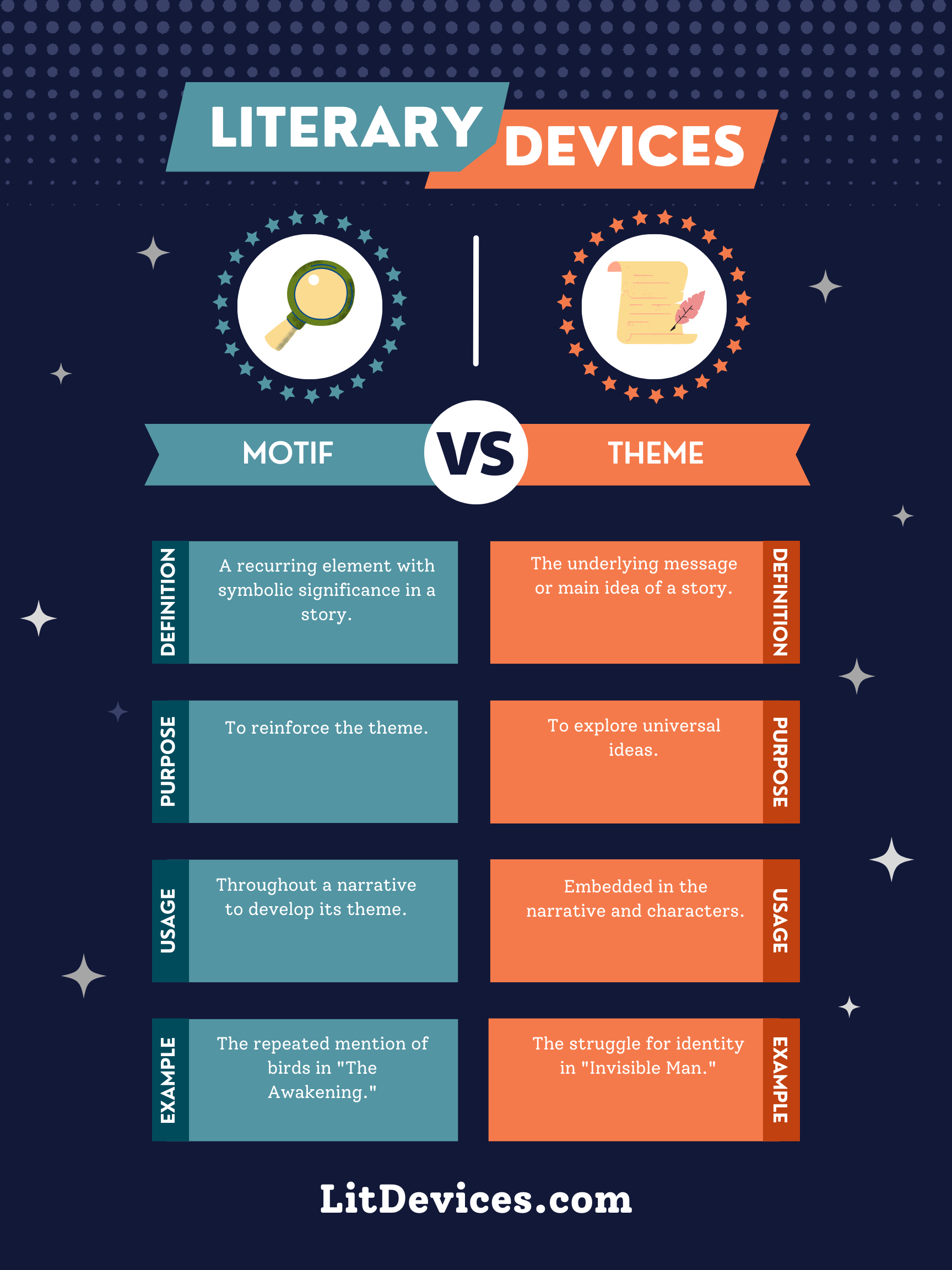Motif is a recurring element that has symbolic significance in a story; Theme is the underlying message or the main idea of the work.
Motif
A motif is a repeated pattern, symbol, or element within a literary work that contributes to the development of the theme or underlying message. It can be a concept, object, or even a word.
🔍 Example: In Shakespeare’s “Macbeth,” the motif of blood represents guilt and remorse, reinforcing the theme of the destructive nature of ambition.
Theme
The theme is the central idea, message, or insight into life that a writer wishes to convey in a literary work. Unlike a motif, which is concrete and recurs throughout the narrative, the theme is abstract and provides a unifying point around which the story revolves.
🌐 Example: In Harper Lee’s “To Kill a Mockingbird,” one of the themes is racial injustice, explored through the characters’ experiences in the plot.
Summary
| Literary Device | Definition | Purpose | Usage | Relevant Examples |
|---|---|---|---|---|
| Motif | A recurring element with symbolic significance in a narrative. | To reinforce the theme and deepen the narrative’s complexity. | Can be a concept, object, or word that repeats throughout the story. | The green light in “The Great Gatsby” symbolizing the pursuit of the American Dream. |
| Theme | The underlying message or main idea of the work. | To offer insights into life or human nature, providing the work with a central, unifying idea. | Abstract and not necessarily repeated, but rather developed through the narrative. | The exploration of love and social expectation in “Pride and Prejudice.” |
Writing Tips
When integrating motif or theme into your writing:
- For Motif: Identify a symbol, word, or object that connects to your central theme. Introduce and revisit it in various contexts throughout your narrative to subtly reinforce your message.
- For Theme: Think about what you want to say about life or human nature. Your theme should emerge naturally from the actions, dialogues, and experiences of your characters, rather than being stated outright.
🖋 Example for Motif: If your theme revolves around the corruption of power, you might use a motif of decaying objects or settings to symbolize the deterioration of moral integrity.
🖋 Example for Theme: To convey a theme of redemption, show your character’s journey from a point of moral failing to one of self-realization and change, impacted by their decisions and interactions.
FAQs
How can I tell a motif from a theme?
A motif is a tangible element that appears repeatedly throughout a story, while a theme is an intangible insight or message that the story explores.
Can a story have multiple motifs and themes?
Yes, many stories contain several motifs and themes, adding layers of meaning and complexity.
Does every motif have to connect directly to the theme?
While motifs typically support the theme, some may serve to enhance the mood or character development instead. The connection to the theme might not always be direct but can add depth in multiple ways.
Exercise
For each description, identify if it is more likely describing a motif or a theme:
- The consistent appearance of rain whenever a character faces a moral dilemma.
- The idea that love conquers all, demonstrated through various relationships in the story.
- The repeated use of darkness to symbolize ignorance.
- The struggle between freedom and responsibility as characters make life-changing decisions.
Answers:
Interesting Literary Device Comparisons
- Allegory vs Symbolism: An allegory is a complete narrative that conveys hidden meanings through symbolic figures, actions, and imagery, often to communicate moral or political messages. Symbolism involves the use of symbols to represent ideas or concepts, adding a layer of meaning to the text.
- Irony vs Satire: Irony involves stating something in a way that implies the opposite of the literal meaning, creating a contrast between expectations and reality. Satire uses humor, irony, and exaggeration to criticize or mock societal norms, individuals, or political entities.
- Foreshadowing vs Flashback: Foreshadowing is a technique used to give an indication or hint of what is to come later in the story. Flashback, on the other hand, is a method

